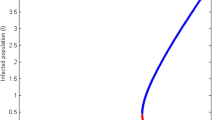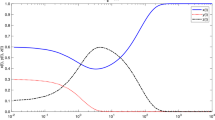Abstract
The aim of this paper is to study the impact of introducing a partially protective vaccine on the dynamics of infection in SIRS models where primary and secondary infections are distinguished. We investigate whether a public health strategy based solely on vaccinating a proportion of newborns can lead to an effective control of the disease. In addition to carrying out the qualitative analysis, the findings are further explained by numerical simulations. The model exhibits backward bifurcation for certain values of the parameters. In these cases the standard basic reproduction number (obtained by inspection of the uninfected state) is not significant. The key threshold is the reinfection level which depends on the relative transmissibility (susceptibility) of secondary, with respect to primary, infected (susceptible) individuals and the relative loss of immunity of vaccinated, with respect to recovered, individuals. If one or all of these ratios decrease, then the threshold increases which increases the possibility to contain the infection by vaccination. The analysis shows further that symptomatic infections can be eliminated by vaccination solely.





Similar content being viewed by others
References
Aguas R, Goncalves G, Gomes MGM (2006) Pertussis: increasing disease as a consequence of reducing transmission. Lancet Infect Dis 6:112–117
Arino J, Cooke KL, van den Driessche P, Velasco-Hernández J (2004) An epidemiology model that includes a leaky vaccine with a general waning function. Discrete Contin Dyn Syst Ser B 4:479–495
Boldin B (2006) Introducing a population into a steady community: the critical case, the centre manifold and the direction of bifurcation. SIAM J Appl Math 66:1424–1453
Carr J (1981) Applications of center manifold theory. Springer, New York
Castillo-Chavez C, Song B (2004) Dynamical models of tuberculosis and their applications. Math Biosci Eng 1:361–404
de Melker HE, Schellekens JFP, Neppelenbroek SE, Mooi FR, Rümke HC, Conyn-van Spaendonck MAE (2000) Reemergence of pertussis in the highly vaccinated population of the Netherlands: observations on surveillance data. Emerg Infect Dis 6(4):348–357
Diekmann O, Heesterbeek JAP, Metz J (1990) On the definition and computation of the basic reproduction ratio \(R_0\) in models for infectious diseases in heterogeneous populations. J Math Biol 28:365–382
Diekmann O, Heesterbeek JAP, Roberts M (2010) The construction of the next-generation matrix for compartmental epidemic models. J Roy Soc Interface 7:873–885
Dushoff J, Huang W, Castillo-Chavez C (1998) Backwards bifurcations and catastrophe in simple models of fatal diseases. J Math Biol 36:227–248
Elomaa A, He Q, Minh NNT, Mertsola J (2009) Pertussis before and after the introduction of acellular pertussis vaccines in Finland. Vaccine 27:7443–7449
Feng Z, Castillo-Chavez C, Capurro AF (2000) A model for tuberculosis with exogenous reinfection. Theor Pop Biol 57:235–247
Gandon S, Mackinnon MJ, Nee S, Read AF (2001) Imperfect vaccines and the evolution of pathogen virulence. Nature 414:751–756
Gomes MGM, White LJ, Medley GF (2004) Infection, reinfection, and vaccination under suboptimal immune protection: epidemiological perspectives. J Theor Biol 228:539–549
Gomes MGM, White LJ, Medley GF (2005) The reinfection threshold. J Theor Biol 236:111–113
Greenhalgh D, Griffiths M (2009) Backward bifurcation, equilibrium and stability phenomena in a three-stage BRSV epidemic model. J Math Biol 59:1–36
Greenhalgh D, Griffiths M (2009) Dynamic phenomena for an extended core group model. Math Biosci 221:136–149
Greenhalgh D, Diekmann O, de Jong MCM (2000) Subcritical endemic steady states in mathematical models for animal infections with incomplete immunity. Math Biosci 165:1–25
Hadeler KP, Castillo-Chavez C (1995) A core group model for disease transmission. Math Biosci 128:41–55
Hadeler KP, van den Driessche P (1997) Backward bifurcation in epidemic control. Math Biosci 146:15–35
Kribs-Zaleta CM (2002) Center manifold and normal forms in epidemic models. In: Castillo-Chavez C et al (eds) Mathematical approaches for emerging and reemerging infectious diseases: models, methods and theory, IMA 125. Springer, New York, pp 269–286
Kribs-Zaleta CM, Martcheva M (2002) Vaccination strategies and backward bifurcation in an age-since-infection structured mode. Math Biosci 177 and 178:317–332
Kribs-Zaleta CM, Velasco-Hernandez JX (2000) A simple vaccination model with multiple endemic states. Math Biosci 164:183–201
Lee GM, LeBaron C, Murphy TV, Lett S, Schauer S, Lieu TA (2005) Pertussis in adolescents and adults: should we vaccinate? Pediatrics 115(6):1675–1684
Mäkinen J, Mertsola J, Mooi FR, Van Amersfoorth S, Arvilommi H, Viljanen MK, He Q (2005) Bordetella pertussis isolates, Finland. Emerg Infect Dis 11(1):183–184
Moghadas SM (2004) Analysis of an epidemic model with bistable equilibria using the Poincaré index. Appl Math Comput 149:689–702
Moghadas SM (2004) Modeling the effect of imperfect vaccines on disease epidemiology. Discrete Contin Dyn Syst Ser B 4:999–1012
Préziosi MP, Halloran ME (2003) Effects of pertussis vaccination on transmission: vaccine efficacy for infectiousness. Vaccine 21:1853–1861
Reluga TC, Medlock J (2007) Resistance mechanisms matter in SIR models. Math Biosci Eng 4:553–563
Safan M, Dietz K (2009) On the eradicability of infections with partially protective vaccination in models with backward bifurcation. Math Biosci Eng 6:395–407
Safan M, Heesterbeek H, Dietz K (2006) The minimum effort required to eradicate infections in models with backward bifurcation. J Math Biol 53:703–718
Seydel R (1988) From equilibrium to chaos: practical bifurcation and stability analysis. Elsevier, New York
Tanaka M, Vitek CR, Pascual FB, Bisgard KM, Tate JE, Murphy TV (2003) Trends in pertussis among infants in the United States, 1980–1999. JAMA 290:2968–2975
van Boven M, Mooi FR, Schellekens JFP, de Melker HE, Kretzschmar M (2005) Pathogen adaptation under imperfect vaccination: implications for pertussis. Proc R Soc Lond B 272:1617–1624
van den Driessche P, Watmough J (2000) A simple SIS epidemic model with a backward bifurcation. J Math Biol 40:525–540
van den Driessche P, Watmough J (2002) Reproduction numbers and sub-threshold endemic equilibria for compartmental models of disease transmission. Math Biosci 180:29–48
World Health Organization (2001) Department of vaccines and biologicals. In: Proceedings of the pertussis surveillance: a global meeting. Geneva, 16–18 October 2000. WHO, Geneva, pp 1–40
Acknowledgments
The authors would like to thank the editor as well as the anonymous referees very much for their invaluable and comprehensive comments which helped in improving the paper. Also, many thanks to the Odo Diekmann group who read the manuscript in their journal club for their comments that helped to improve it.
Author information
Authors and Affiliations
Corresponding author
Appendix
Appendix
Proof of Proposition 5
We write the quadratic equation (26) as
We first define the following quantities
Now we evaluate
and hence
Also,
Recall \( \mathcal A =B_1^2\). Hence,
\(\square \)
Direction of bifurcation
To get the direction of bifurcation at the uninfected equilibrium, we use the implicit function theorem
We find that \(F_\kappa \) at \(\lambda =0\) is equal to \(C_\kappa = - C_1 <0\). Hence the direction of bifurcation is given by the sign of \(F_\lambda \) which is the value of \(B\) at \(\kappa =\kappa _v\). This expression is (see below), up to a positive factor,
Proof of formula (42)
At \(\kappa = \kappa _v\), then
Since \((1-p)(q\alpha +\mu )X_1 + r g p b \sigma (\alpha +\mu )>0\), then the sign of \(B\) depends on the sign of
which is formula (42). \(\square \)
Proof of formula (36)
where
Inequality (43) is rewritten as
where
Thus \(p\) lies between \( \frac{-\xi _2 \pm \sqrt{\xi _2^2 - \xi _1\xi _3}}{\xi _1}\) \(\square \)
i.e., \( \frac{-[\kappa ^2 g^2 \phi _1\phi _2 - \kappa g X_1(\alpha +\mu )\eta _2] \pm \sqrt{\xi _2^2 - \xi _1\xi _3}}{\kappa ^2 g^2 \phi _2^2}.\)
As the upper root involves \(+\sqrt{\xi _2^2 - \xi _1\xi _3}>1\), we need to consider only the lower root. Hence
The term under the square root is
where
Note that
where
Thus
Now, we evaluate \(G_3\). We have
and
Hence,
Note that
Thus,
Rights and permissions
About this article
Cite this article
Safan, M., Kretzschmar, M. & Hadeler, K.P. Vaccination based control of infections in SIRS models with reinfection: special reference to pertussis. J. Math. Biol. 67, 1083–1110 (2013). https://doi.org/10.1007/s00285-012-0582-1
Received:
Revised:
Published:
Issue Date:
DOI: https://doi.org/10.1007/s00285-012-0582-1
Keywords
- Two stage SIRS model
- Backward bifurcation
- Vaccination coverage
- Eradication effort
- Reinfection
- Controllability




